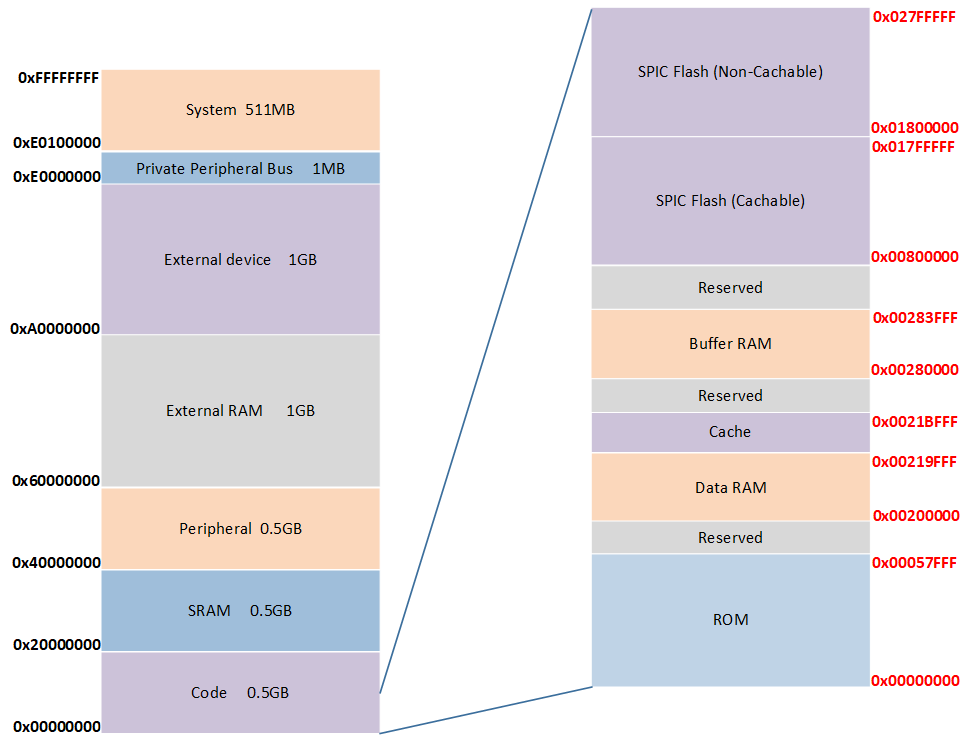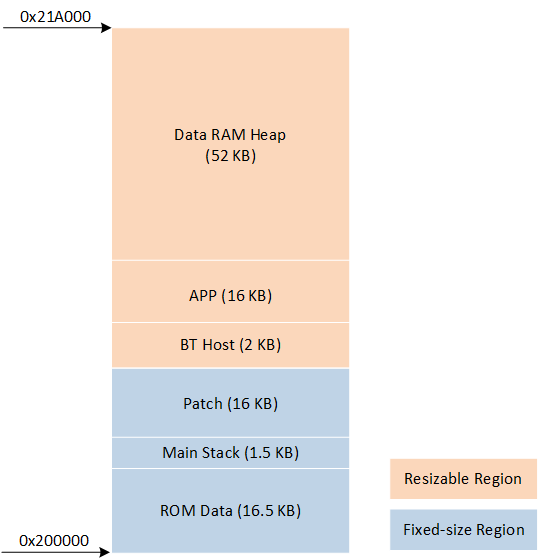Memory
This chapter primarily introduces the memory system of the RTL8752H.
Memory Map
The memory system of the RTL8752H is designed based on the memory mapping architecture of the Arm Cortex-M0+ and primarily consists of ROM, RAM, Cache, Flash, and eFuse. Its design involves mapping the ARM address map to the memory regions defined by Realtek, as illustrated in Memory Mapping of RTL8752H.

Memory Mapping of RTL8752H
The distribution of Realtek defined regions is shown in Memory Regions Defined by Realtek.
Region |
Address Space |
Size |
|---|---|---|
[0x00000000, 0x00057FFF] |
352 KB |
|
[0x00200000, 0x00219FFF] |
104 KB |
|
[0x0021A000, 0x0021BFFF] |
8 KB |
|
[0x00280000, 0x00283FFF] |
16 KB |
|
SPIC Flash (Cacheable) |
[0x00800000, 0x017FFFFF] |
Maximum mapping space is 16 MB |
SPIC Flash (Non-Cacheable) |
[0x01800000, 0x027FFFFF] |
Maximum mapping space is 16 MB |
/ |
1 KB |
Note
The RTL8752H's Cache has dedicated RAM, and this RAM can also be configured for use as general-purpose RAM. For a detailed introduction, please refer to Cache.
The size of the Flash is determined by the part number of SoC used in practice.
ROM
The ROM address space of the RTL8752H is [0x00000000, 0x00057FFF], with a total size of 352KB.
The ROM is embedded with programs such as the Bootloader, BT Controller, Flash Driver, and Power Manager. Some of these modules (such as the Flash Driver) are exported to developers in the form of header files and ROM symbols. Using the interfaces in the ROM can reduce the code size of applications.
RAM
The RAM of RTL8752H is divided into two parts:
Region |
Address Space |
Size |
Usage |
|---|---|---|---|
[0x00200000, 0x00219FFF] |
104KB |
Used for storing data, executing code, and heap allocation. |
|
[0x00280000, 0x00283FFF] |
16KB |
Primarily used for heap allocation, and the Realtek Bluetooth protocol stack uses this heap block by default. |
Data RAM
The Data RAM of the RTL8752H is by default divided into 6 regions, distributed as follows:

Data RAM Layout
Each region has a specific purpose:
Region |
Usage |
Is Size Adjustable |
|---|---|---|
ROM Data |
Stores global variables and static variables in ROM code. |
No |
Main Stack |
Used for the startup process and interrupt service routines. |
No |
Patch RAM |
Global variables and static variables for storing Patch code, as well as code executed in RAM. |
No |
BT Host RAM |
Stores global variables and static variables of the BT Host code, as well as code executed in RAM. |
Yes |
APP RAM |
Stores global variables and static variables of the APP, as well as code executed in RAM. |
Yes |
Data RAM Heap |
Used for dynamically allocating memory for ROM code, Patch code, and APP code. |
Yes |
Three resizable RAM regions can be customized in size through the macros UPPERSTACK_GLOBAL_SIZE and APP_GLOBAL_SIZE in the mem_config.h file under the project directory.
Note
The macro UPPERSTACK_GLOBAL_SIZE must be set according to the version of the BT Host Image, so please pay attention to the BT Host version and release notes.
Buffer RAM
The address space of Buffer RAM is [0x00280000, 0x00283FFF], with a total size of 16KB, and its layout is as follows:

Buffer RAM Layout
Each region has a specific purpose:
Region |
Usage |
Is Size Variable |
|---|---|---|
ROM Data |
Stores global variables and static variables from ROM code. |
No |
Buffer RAM Heap |
Used for dynamic memory allocation for ROM code, Patch code, and APP code (Realtek Bluetooth protocol stack uses this heap by default). |
No |
Cache
The cache size of the RTL8752H is 8KB, corresponding to the address space [0x0021A000, 0x0021BFFF]. The cache, in conjunction with the SPI Flash Controller (SPIC), can accelerate the read and write access speeds of the Flash.
The cache of RTL8752H can be configured as Shared Cache RAM for storing data and executing code. Users can control the size of cache configured as RAM through the macro SHARE_CACHE_RAM_SIZE in the mem_config.h file under the project directory.
Macro |
Cache Size |
Data RAM Size |
Applicable Scenarios |
|---|---|---|---|
0 |
8 KB |
0 KB |
Running a large amount of Flash code. |
4 |
4 KB |
4 KB |
Run some Flash code, with requirements for the efficiency of Flash code execution. |
8 |
0 KB |
8 KB |
Basically no need to run Flash code, or no efficiency requirements for running Flash code. |
Note
The macro SHARE_CACHE_RAM_SIZE is set to 0 by default in SDK projects.
Heap Management
As introduced above, the RTL8752H is configured by default with two Heap areas (Data RAM Heap and Buffer RAM Heap) for developers to dynamically allocate memory.
The inc/os/os_mem.h provides the APIs for Heap Management:
API |
Description |
|---|---|
Allocate memory. |
|
Allocate memory and initialize it to 0. |
|
Allocate memory and align it according to the specified method. |
|
Release the allocated memory. |
|
Release memory allocated with specified alignment. |
|
Count the unused size of the specified RAM type Heap. |
When calling APIs related to allocating, there will be different strategies based on the input parameter ram_type:
When ram_type is RAM_TYPE_DATA_ON, memory is allocated from the Data RAM Heap. If the Data RAM Heap is insufficient, it will automatically allocate from the Buffer RAM Heap.
When ram_type is RAM_TYPE_BUFFER_ON, memory is allocated from the Buffer RAM Heap. If the Buffer RAM Heap is insufficient, an out-of-space error will be reported.
RAM Usage of the Application
The RAM usage of the application primarily includes two parts:
The usage of static RAM after compilation
The usage of dynamically allocated memory from the Heap
This section will introduce the statistical methods, and the RAM usage in Bluetooth applications.
Static RAM Usage Statistics Method
After the APP is compiled, the usage of static RAM can be obtained by querying the MAP file generated during compilation.
The size of static RAM on Data RAM can be obtained by searching the RAM_DATA_ON keyword in the MAP file. Data RAM (Static) Usage Statistics is a screenshot of the RAM_DATA_ON area in the MAP file compiled by Keil, where you can see the execution region start address, load region start address, and actual used size of the RAM_DATA_ON area.

Data RAM (Static) Usage Statistics
If the APP is configured with Share Cache RAM, the size of static RAM on Share Cache RAM can be obtained by retrieving the CACHE_DATA_ON keyword in the MAP file. Share Cache RAM Usage Statistics is a screenshot of the MAP file compiled by Keil, where you can see the execution region start address, load region start address, and actual used size of the CACHE_DATA_ON area.

Share Cache RAM Usage Statistics
Heap Usage Statistics Method
By calling os_mem_peek(), you can obtain the allocatable size of the specified RAM type Heap.
RAM Usage Statistics
For a Bluetooth application, the Realtek platform and Bluetooth protocol stack code will occupy a portion of the RAM resources during runtime. Therefore, this section will count the amount of RAM used by Realtek in the Bluetooth application and calculate the actual available RAM size left for APP developers.
According to the default Bluetooth settings in MP Tool under :
LE Master Link Num: 2
LE Slave Link Num: 2
Support LE AE ADV: Enable
PSD Enable: Enable
The statistical results of RAM usage are as follows:
Region |
Total Size |
Usage by Realtek |
RAM Size Available for APP |
|---|---|---|---|
Data RAM Heap + APP RAM |
68 KB |
28 KB |
40 KB |
Buffer RAM Heap |
14.5 KB |
13 KB |
1.5 KB |
Note
Usage by Realtek mainly accounts for the Heap usage in Bluetooth applications, excluding static RAM usage.
The above statistics allocate 2KB by default to BT Host RAM, making the total size of Data RAM Heap + APP RAM 68KB.
Patch updates may cause changes in Realtek usage, so the available RAM size for the APP should be based on the actual situation.
RAM Usage Optimization
If you want to further increase the amount of RAM available for the app, the following two methods can be considered.
Method 1: Change Bluetooth Settings
By modifying Bluetooth settings in the MP Tool under the interface, such as the number of Bluetooth links, AE and PSD functions, etc., the purpose of increasing the RAM available for the app can be achieved.

Modify Bluetooth Settings Through MP Tool
If the default Bluetooth settings are changed as follows:
LE Master Link Num: 2->0
LE Slave Link Num: 2->0
Support LE AE ADV: Enable->Disable
PSD Enable: Enable->Disable
The RAM usage statistics will be changed to:
Region |
Total Size |
Usage by Realtek |
RAM Size Available for APP |
|---|---|---|---|
Data RAM Heap + APP RAM |
68 KB |
22 KB |
46 KB |
Buffer RAM Heap |
14.5 KB |
10.7 KB |
3.8 KB |
Method 2: Turn Off the LOG System
By unchecking the LOG Config option in the interface of MP Tool, an additional 1.5KB of RAM can be freed for APP use.
Flash
See Flash.
eFuse
eFuse is a one-time programmable memory used to store important and fixed information, such as UUIDs, keys, and other information that will only be configured once.
Each bit in eFuse can only be changed from 1 to 0 and cannot be changed from 0 to 1, so extreme caution must be exercised when updating eFuse.
2.5V (±10%) power supply must be applied when programming eFuse.
Realtek provides MP Tool to update eFuse.
See Also
Please refer to the relevant API Reference: